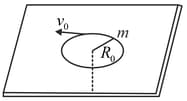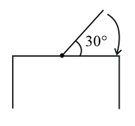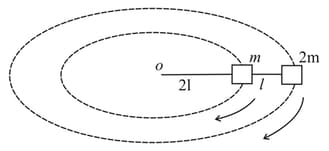In a non-uniform circular motion of a body, its radial acceleration remains constant in magnitude but the magnitude of tangential acceleration changes with time.
Important Questions on Motion in a Plane
A clock has a continuously moving second's hand of length. The average acceleration of the tip of the hand (in units of ) is of the order of :
A mass moves in a circle on a smooth horizontal plane with velocity at a radius . The mass is attached to a string which passes through a smooth hole in plane as shown.

The tension in the string is increased gradually and finally moves in a circle of radius . The final value of the kinetic energy is:

Two blocks of masses and connected by a massless string move along concentric horizontal circles on a horizontal frictionless table with as fixed point as shown in the figure. If is the period of motion, the tension in the longer part of the string is (Neglect the dimensions of the blocks when compared with the lengths of the string).


